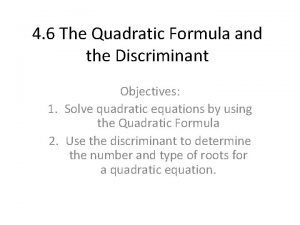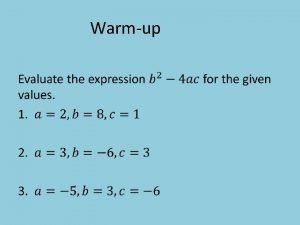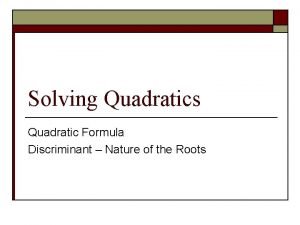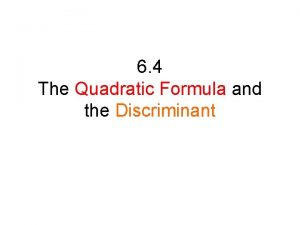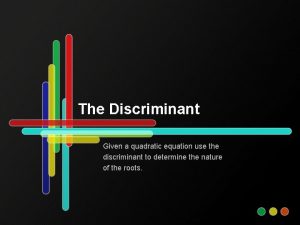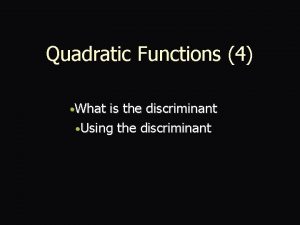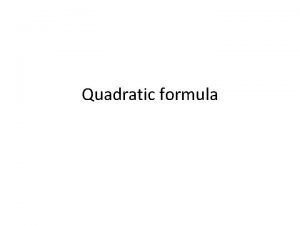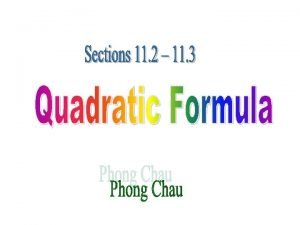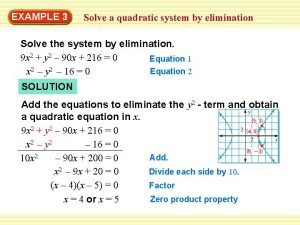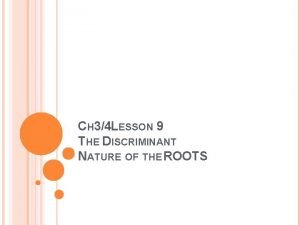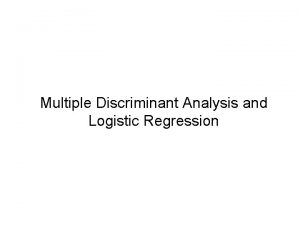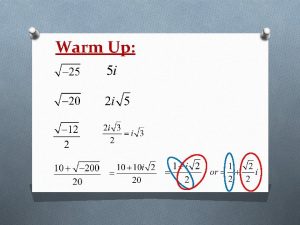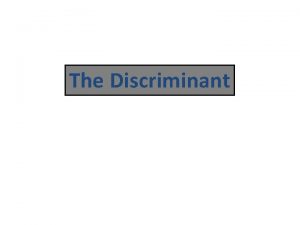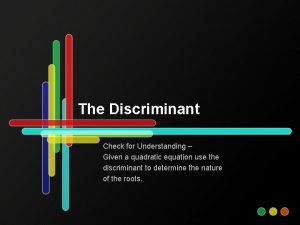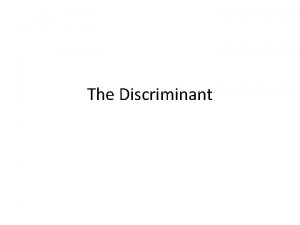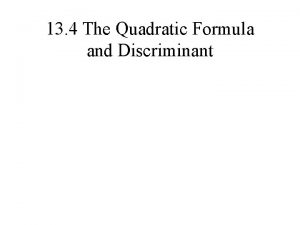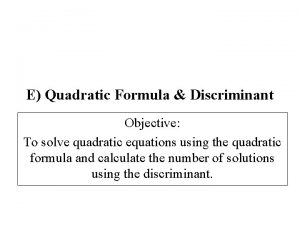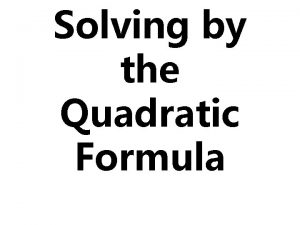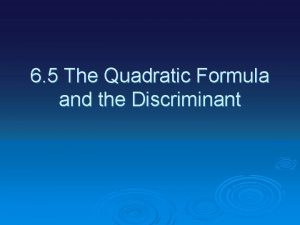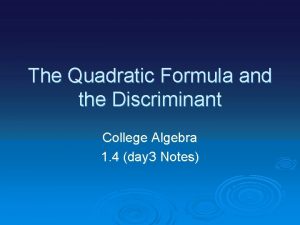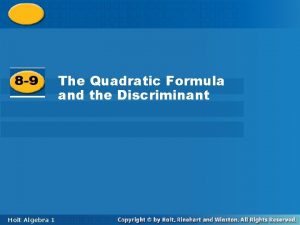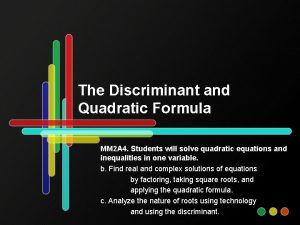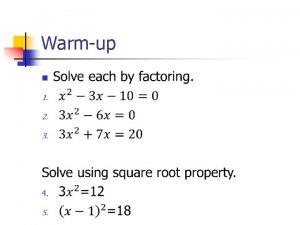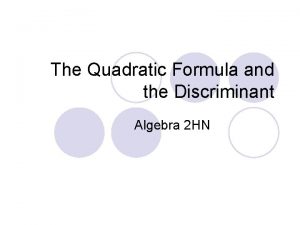5 6 The Quadratic Formula and the Discriminant



















- Slides: 19

5. 6 The Quadratic Formula and the Discriminant Algebra 2

Learning Target l Solve equations using the quadratic formula. l Use the discriminant to determine the nature of the roots of a quadratic equation.

Derive the quadratic formula from ax 2 + bx + c = 0 a≠ 0 General form of a quadratic equation. Divide all by a Simplify Subtract c/a on both sides. Multiply by ½ and square the result.

Derive the quadratic formula from ax 2 + bx + c = 0 a≠ 0 Add the result to both sides. Simplify Multiply by common denominator Simplify

Derive the quadratic formula from ax 2 + bx + c = 0 a≠ 0 Square root both sides Simplify Common denominator/subtract from both sides Simplify

Quadratic Formula l The solutions of a quadratic equation of the form ax 2 + bx + c with a ≠ 0 are given by this formula: MEMORIZE!!!!

Ex. 1: Solve t 2 – 3 t – 28 = 0 a = 1 b = -3 c = -28 There are 2 distinct roots—Real and rational.

Ex. 1: Solve t 2 – 3 t – 28 = 0 CHECK: t 2 – 3 t – 28 = 0 72 – 3(7) – 28 = 0 49 – 21 – 28 = 0 49 – 49 = 0 CHECK: t 2 – 3 t – 28 = 0 (-4)2 – 3(-4) – 28 = 0 16 + 12 – 28 = 0 28 – 28 = 0

Ex. 1: Solve t 2 – 3 t – 28 = 0 -- GRAPH

Ex. 2: Solve x 2 – 8 x + 16 = 0 a = 1 b = -8 c = 16 There is 1 distinct root—Real and rational.

Ex. 2: Solve x 2 – 8 x + 16 = 0 CHECK: x 2 – 8 x + 16 = 0 (4)2 – 8(4) + 16 = 0 16 – 32 + 16 = 0 32 – 32 = 0 There is 1 distinct root—Real and rational.

Ex. 2: Solve x 2 – 8 x + 16 = 0 -GRAPH

Ex. 3: Solve 3 p 2 – 5 p + 9 = 0 a = 3 b = -5 c = 9 There is 2 imaginary roots.

Ex. 3: Solve 3 p 2 – 5 p + 9 = 0 NOTICE THAT THE PARABOLA DOES NOT TOUCH THE X-AXIS.

Note: l These three examples demonstrate a pattern that is useful in determining the nature of the root of a quadratic equation. In the quadratic formula, the expression under the radical sign, b 2 – 4 ac is called the discriminant. The discriminant tells the nature of the roots of a quadratic equation.

DISCRIMINANT l The discriminant will tell you about the nature of the roots of a quadratic equation. Equation t 2 – 3 t – 28 = 0 Value of the discriminant Roots b 2 – 4 ac = (-3)2 – 4(1)(-28) = 121 {7, - 4} x 2 – 8 x + 16 = 0 b 2 – 4 ac = {0} Nature of roots 2 real roots 1 real root (-8)2 – 4(1)(16) = 0 3 p 2 – 5 p + 9 = 0 b 2 – 4 ac = (-5)2 – 4(3)(9) = -83 2 imaginary roots

Ex. 4: Find the value of the discriminant of each equation and then describe the nature of its roots. 2 x 2 + x – 3 = 0 a = 2 b = 1 c = -3 b 2 – 4 ac = (1)2 – 4(2)(-3) = 1 + 24 = 25 The value of the discriminant is positive and a perfect square, so 2 x 2 + x – 3 = 0 has two real roots and they are rational.

Ex. 5: Find the value of the discriminant of each equation and then describe the nature of its roots. x 2 + 8 = 0 a=1 b=0 c=8 b 2 – 4 ac = (0)2 – 4(1)(8) = 0 – 32 = – 32 The value of the discriminant is negative, so x 2 + 8 = 0 has two imaginary roots.

Pair-share l pp. 295 #16 -45 even
 Quadratic formula pop goes the weasel
Quadratic formula pop goes the weasel 4-6 the quadratic formula and discriminant
4-6 the quadratic formula and discriminant 8-9 the quadratic formula and the discriminant
8-9 the quadratic formula and the discriminant Discrimanant formula
Discrimanant formula Quadratic for.ula
Quadratic for.ula Discriminant and nature of roots
Discriminant and nature of roots Discriminant chart
Discriminant chart Quadratic function discriminant
Quadratic function discriminant Discriminant in math
Discriminant in math Discriminant equation
Discriminant equation Discriminant formula
Discriminant formula Jaundice
Jaundice Quadratic quadratic systems examples
Quadratic quadratic systems examples Nature of roots of quadratic equation examples
Nature of roots of quadratic equation examples Discriminant and nature of roots
Discriminant and nature of roots Logistic regression and discriminant analysis
Logistic regression and discriminant analysis Types of discriminant solutions
Types of discriminant solutions Face validity definition
Face validity definition Negative discriminant graph
Negative discriminant graph Understanding the discriminant
Understanding the discriminant

